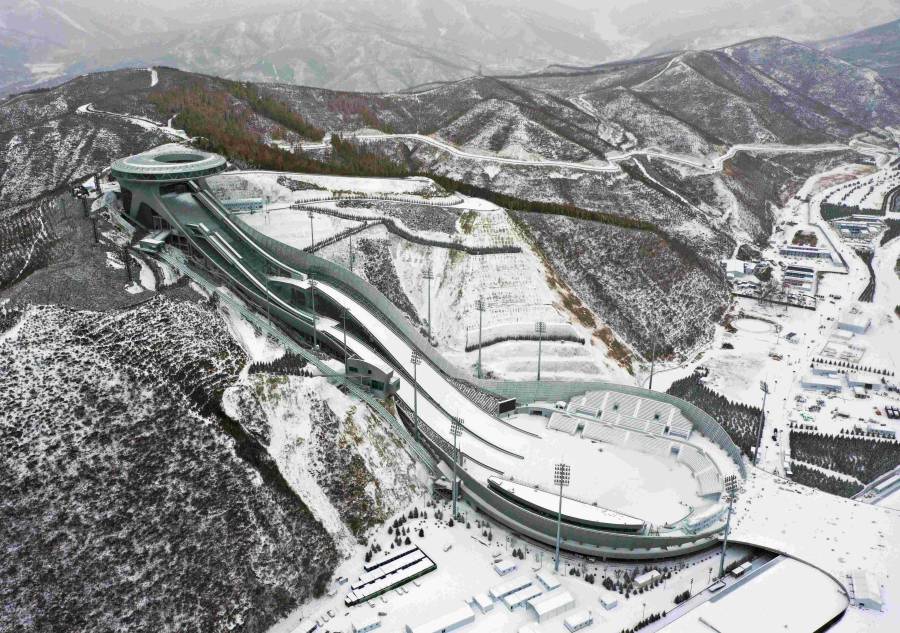At the Beijing 2022 Winter Olympic Games, athletes from around the world think highly of the two snow sports venues,“Snow Ruyi” National Ski Jumping Center in Hebei’s Zhangjiakou city, and “Snow Flying” Shougang Big Air in Beijing’s Shijingshan district. The question on many competitors’ lips is, what is the thought behind the venues’ designs?

The National Ski Jumping Center, also called "Snow Ruyi", is in Zhangjiakou, Hebei province. (PHOTO: XINHUA)
At the outset, Zhang Li, the designer of the two sports venues and dean of School of Architecture, Tsinghua University, was not familiar with the two competition events. From watching previous games, he gradually began to understand the use of the venues and realized that the beauty of sports is determined by the posture and curve presented by the athletes in the air. After many discussions and brain storming sessions, the vision of “Snow Ruyi” and “Snow Flying” became clear to Zhang.
“Snow Ruyi” National Ski Jumping Center—a gift from nature
The design of “Snow Ruyi” is inspired by the traditional Chinese ornament Ruyi. In Chinese culture, Ruyi, usually made of jade or gold, represents auspiciousness.
When Zhang received the track curve of the National Ski Jumping Center, provided by the International Skiing Federation (ISF), he decided to create the track capped by the top of “Snow Ruyi”, a circular room with an outer diameter of 80 meters and an inner diameter of 40 meters. It can be also be used for sightseeing after the competition.
The installation of a huge cantilevered building over the track, unrelated to the athletes, is unprecedented internationally. Zhang was not sure whether it would be certified by the ISF. However, considering the sustainable use of the stadium after the Games, the ISF finally agreed on the design with Chinese cultural characteristics. Thus the overall shape of “Snow Ruyi” was established.
The top of “Snow Ruyi” is composed of two jumping platforms, which can accommodate 500 people, and is more than 130 meters above the ground. The two S-shaped courses look like the main body of a Ruyi hanging in the air, while the bottom consists of a soccer field and audience area. The two courses are built away from the mountain, with the aim of protecting the surface runoff and ecological restoration and animal migration in the future.
“Snow Flying” Shougang Big Air—the first track-shared platform
The idea of “Snow Flying” is borrowed from Dunhuang Murals’ Flying Apsaras, whose fluttering ribbons are imitated by the profile curve of the venue. Resembling the movement of the Flying Apsaras, the Shougang Big Air perfectly combines the snow sports with traditional Chinese culture.

Shougang Big Air is located in Beijing's Shijingshan district. (PHOTO: XINHUA)
The Shougang Big Air is set to host freestyle skiing and snowboard big air events. An innovative design of the Shougang Big Air is the availability of a shared track, making it possible to switch the two tracks quickly according to the types of the competition events.
In the past, the freestyle skiing event is held in mountainous areas, while the snowboard big air event happen in the urban cities. The two events require two entirely different tracks, and they have never shared the same venue.
The ISF expects to see more snow sports events to be hosted in Shougang and idea of merging the two events into one venue seemed to make sense to the design team.
With the help of his friend Ge Yi, an architect of steel structures, Zhang drew the sketch of the track transformation, which perfectly combines the characteristics of the two competition events—the track for assisting skiing and landing remain untouched, and the slope curve is properly changed, making it possible for two different events to compete on the same track.
Source: Science and Technology


